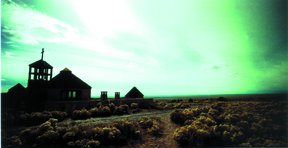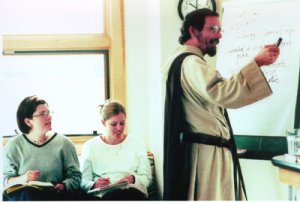Mystic Monks: CC Students Enjoy Their Time with Carmelites
By Dave Curtin
Photos by John Epperson
an Decker is trying to seduce Mother Tessa. Is this what a college education is all about?

It is at Colorado Collegeís remote Baca campus in the San Luis Valley, where the desert meets the mountains, the deer graze freely, and Crestone and Kit Carson peaks stand sentry.
Colorado College students come here from the schoolís main campus in Colorado Springs to study everything from sustainable development to biology, anthropology to Renaissance astronomy.
The 300-acre campus on mostly undeveloped land at the base of the Sangre de Cristo Mountains is used 50 weeks a year by students. The campus has a lodge for two dozen students, a library, and a classroom building. A private restaurant on the grounds contracts with the college for food service.
The Baca campus, opened in 1987, takes its name from its location, the Jose Luis Maria Baca Land Grant in the San Luis Valley.

CCís unusual Block Plan -- in which students focus on one class for 3 1/2 weeks before moving on to their next course -- allows them to spend a week in the field without missing time in other classes.
Christian Mystics
This week Baca students are wrapping up an intense 3 1/2 week course on the history of Christian mysticism, taught by Carmelite monks who worship and work at the neighboring Nada Hermitage Monastery.
The monks re-create the simple, contemplative existence of the original hermits of Mount Carmel, who lived in caves in 11th century Palestine. Theyíve taken vows of poverty, chastity and obedience. "No fuss, no lust, no rust," they say.
The monastery, four hours south of Denver, is one of the most unconventional entities in the Roman Catholic Church. The 12 male and female monks, ages 27 to 56, live separately in primitive cabins but together in a self-sufficient community. Itís the first Roman Catholic monastery in centuries to include both men and women.
"You guys are all beautiful inwardly and outwardly," student Decker says during a no-holds-barred question and answer session with the monks in the Baca library, where a fire crackles in the fireplace. "How do you keep, you know, from going nuts? I mean, I want to marry Mother Tessa."
Discussing celibacy
It was a question about the monksí vow of celibacy.
"Itís not that we donít want that. Itís just that we want our relationship with God more," volunteers Sister Ceil McGowan, a former inner-city Chicago schoolteacher who decided she could better contribute to society as a monk after becoming disillusioned as a teacher. "There were 250 teachers, and the day after payday, 30 would be absent," she says.
Far from the daily grind, in a wild land where coyotes howl and stardust sprinkles a velvet canvas overhead, 25 students spend a week at the Baca campus studying the mystic tradition exemplified by John of the Cross, Teresa of Avila and St. Francis, and lived today by the Carmelite monks.
The class, called "Fire and Light," is taught by Father Dave Denny, the prior of the Nada Hermitage Monastery, and Mother Tessa Bielecki, the abbess.
By studying with this band of merry monks, the students see firsthand the contemplative life of modern mystics. Itís one of the most popular classes at the private liberal arts college. But itís not navel gazing. Students discuss difficult readings, write essays and take tests.
"This class is legendary at CC," says Heather Beeson, a senior biology major. "It requires you to go a little deeper, to go inside youself.
"This is a class you donít leave without it changing your life," says Amanda "Dez" Menendez, a creative-writing and studio art major, as she walks a wooded path to class one morning. "Christian mysticism isnít necessarily something Iíll do in my life, but the monks are incredible. Thereís so much laughter thatís so pure. Itís like a community you read about in a history book, but itís happening here today.
"My beliefs are being shot down," Menendez says. "Christians are hypocrites -- thatís gone. Priests are sexist -- thatís gone. This is a lot more than just a class. How could you not be touched by this community? How could you not be inspired? How could you not feel your spirituality? These guys blow you away."
"Sometimes there are strange stereotypes about monks," says Denny, whose sand-colored habit covers his patched jeans and wool workshirt.
"The stereotype is weíre humorless, weíre antisocial, we hate the world, weíre misfits."
Not these monks. They bounce back and forth between solitude and boisterous frivolity. And so do the students.
"One of the best things for the students is meeting the other monks," Denny says. "Some of the textbooks we study are very difficult, going back 1,500 years, about some guy who lived in Egypt in such a different culture, and you really have to stretch to understand. By meeting the monks, they meet living representations of this [mystic] tradition.
"The students are very interested in how in the world a person late in the 20th century in this advanced technological society ends up as a monk and a hermit," says Denny, 45, who joined the community when he was 21. The monks include a former medical researcher, a Peace Corps volunteer, a natural-food restaurant operator, a nurse and an IRS agent.
The class offers a stark contrast to the natural sciences many CC students study.
"Theyíre trained to think analytically rather than reflectively," Bielecki says. "It takes courage for them to take a class like this."
"I spend the rest of my year discussing concrete problems with answers at the end," says Marissa Olson, a physics major from Lakewood. "This is a different way of looking at things."
Itís in this barren land so empty but so full of wilderness where mystics -- and students -- free from lifeís daily clutter can reflect on whatís important. Sometimes they have a revelation.
"A friend said, ĎIf you donít do anything else at CC, take this class. It will change your life,í" says Kate Henrioulle, a senior biology major. "And it has."
The week before she arrived at the Baca, she was applying "like crazy" to graduate schools. Then she had an epiphany.
"I was going to study marine science. On my second day here, I decided my life is out of balance. Academic scientists are unforgiving. Thereís no room for anything else in your life. Iíve seen how these monks are so serious but find time for laughter. Theyíve shown me how to have balance in my life."
Henrioulle may still go to graduate school someday, but sheíll probably study something else, perhaps education. Students participate in the monastic rhythm of study, contemplation and levity. The levity includes an afternoon hike at Sand Dunes National Monument, 30 miles away, on a cool, crisp day.
The students quickly scatter into specks on the high sandy ridges and let out childlike squeals as they jump, roll and slide down the mammoth dunes like children on a favorite sledding hill.
They may not know it, but they are in the mystic mode. Indeed, contemplatives look at the world like a child does. "The monk is not sophisticated. He is simple. He need not be entertained by garrulousness, glibness or televised seesaws," writes Father William McNamara, co-founder of the monastery. "Like a child, he is fascinated by frogs, loons, trees, flowers and snowflakes."
But thereís another lesson at the sand dunes, and the students will be asked to write about it. "We go to the dunes to see how the geography is a part of the mystic tradition," Denny says.
On the last night of their visit, students attend 5 p.m. mass with the monks at their Sangre de Cristo Chapel, followed by a pizza party and a high-spirited talent show at Agape -- the monksí dining room and common house.
Students play mandolin, sing and tap dance. After a while, Mother Tessa grabs a guitar and breaks into song, saying sheís inspired by the temptations put before her this week. "I will be no manís wife. I expect to be single all the days of my life," she croons.
Kate Henrioulle does an exuberant tap dance on a piece of plywood then stops to recite a quote from Englishman Gerard Manley Hopkins.
"This sums up the class for me," she announces to the group. "What is all this juice and all this joy?"
This article, which originally appeared in The Denver Post on Nov. 22, is reprinted with permission.
Back to Index